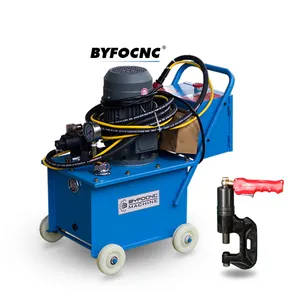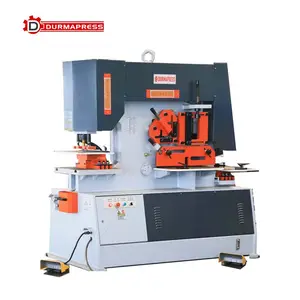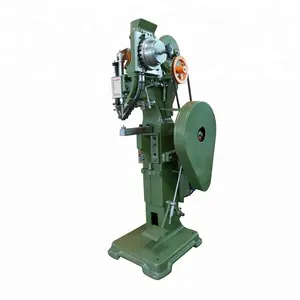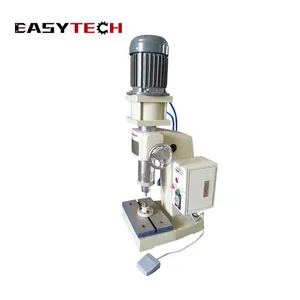What is Hydraulic Riveting System
A Hydraulic Riveting System is a specialized tool designed to join materials together using hydraulic pressure, particularly in applications where solid rivets or other permanent fasteners are needed. These systems are commonly used in industries that require durable and high-strength fastenings, such as automotive, aerospace, and construction. The hydraulic riveting system is also favored for its ability to provide consistent force and to handle a wide range of riveting operations.
The working principle of a hydraulic riveting system involves a hydraulic pump that generates pressure, which is then transferred through hoses to a hydraulic cylinder. The cylinder contains a piston that moves back and forth to deliver the pressure to a rivet set within a tool head. As the piston advances, it compresses the fluid within the system, which in turn creates a high-pressure hydraulic force that drives the rivet through the material. This process is not only efficient but also allows for greater control over the force applied, which is crucial when working with different materials and thicknesses.
These systems can be either portable, with a lightweight pump and hoses, or stationary, integrated into a factory assembly line. The users of hydraulic riveting systems can vary from small workshops to large manufacturing plants, depending on their specific needs and the scale of their operations. The versatility and power of these systems make them an indispensable tool for ensuring a secure and permanent connection in industrial settings.
Types of Hydraulic Riveting System
Hydraulic riveting systems come in various types to accommodate different rivet sizes and materials. Here are some common types:
-
Hydraulic Pneumatic Riveting System: This type is widely used due to its versatility and cost-effectiveness. It typically consists of a hydraulic cylinder, pump, and control valves. The system is suitable for a range of applications including automotive, construction, and manufacturing.
-
Hydraulic Spin/Pull Riveting System: Spin/pull riveting systems can handle larger rivets and offer the ability to not only set the rivet but also to pull it back after it has been set. These are often used where high strength and reliability are key factors.
-
Hydraulic Power Units: These units supply the pressure needed for riveting. They are compact and can be located remotely from the riveting tool, offering flexibility in setup configurations.
-
Hydraulic Rivet Squeezers: Specially designed for setting rivets in awkward or confined spaces, these squeezers provide a mechanical advantage to apply the necessary force to set the rivet.
-
Hydraulic Hand Pumps: For portable applications where electricity is not available, hydraulic hand pumps are used to pressurize the hydraulic system manually. They are often employed in remote locations or for smaller scale tasks.
How to choose Hydraulic Riveting System
When selecting a hydraulic riveting system for your business needs, consider the type of material you will be working with, the size and complexity of your projects, and the level of operator skill available. For instance, if you frequently work with high-strength materials such as stainless steel or aluminum, you might opt for an orbital riveting machine due to its ability to maintain consistent pressure over long periods for proper setting of rivets. On the other hand, if you handle a variety of materials with different thicknesses, an impact riveting machine might be more versatile since it can adjust to various sizes of rivets.
The level of automation you desire is also crucial; fully automated systems with an integrated PLC might be suitable for high-volume production lines where efficiency is paramount. If you're considering an orbital riveting system, think about whether you need specialized tooling for your particular application.
Lastly, after-sales service should not be overlooked. Check whether suppliers provide online support or field maintenance services to ensure continuous operation without significant downtime.
About Hydraulic Riveting System on Alibaba.com
Alibaba.com stands as a global marketplace connecting buyers with suppliers of hydraulic riveting systems from various regions. With an expansive selection from numerous suppliers around the world, Alibaba.com ensures businesses can find the precise type of hydraulic riveting system they need to meet their operational requirements. Whether you need standard industrial riveters or specialized multi-function machines, this platform caters to all by offering an array of options without compromising on quality or ease of use.
Understanding the diverse needs across different industries, Alibaba.com provides access to machinery that spans various applications—from construction sites to garment shops—enabling businesses to efficiently source equipment tailored to their specific project demands. Moreover, with services like Trade Assurance, buyers have peace of mind knowing their transactions are protected until delivery is completed.
For businesses seeking to enhance their productivity through streamlined operations or those looking to resell hydraulic riveting systems with confidence in their marketability, Alibaba.com's vast network offers ample opportunity. With its user-friendly interface and support in local languages, Alibaba.com simplifies international trade, making it easier than ever for small and medium-sized businesses to compete in the global market.
Common FAQs for Hydraulic Riveting System
What is a hydraulic riveting system used for?
A hydraulic riveting system is used for fastening and securing components in manufacturing plants, providing a high level of structural integrity by using hydraulic force to set rivets.
How does a hydraulic riveting system work?
A hydraulic riveting system works by using a hydraulic pump to generate high pressure, which is then used to compress a rivet within its sleeve until it contacts the workpiece.
What are the different types of hydraulic rivets?
There are several types of hydraulic rivets, including single-action, double-action, and manual hydraulic rivets. Each type offers different advantages and is suited to specific applications.
What materials can be used with hydraulic rivets?
Hydraulic rivets can be utilized with a wide range of materials including aluminum, steel, stainless steel, and various other alloys based on the specific application requirements.
What should I consider when choosing a hydraulic riveting system for my business?
Consider the system’s performance in terms of stroke length, force output, and durability. Also, assess whether the system can handle the types of rivets you plan to use.
Can hydraulic riveting systems be integrated into existing manufacturing lines?
Yes, hydraulic riveting systems can often be integrated into existing manufacturing lines to improve efficiency and productivity.
How do I ensure the quality of a hydraulic riveting system?
Look for systems that provide machinery test reports and adhere to industry standards. Suppliers may also offer after-sales services like online support or video technical support to ensure proper setup and operation.
Are there any safety considerations when using a hydraulic riveting system?
Always follow safety guidelines when using a hydraulic riveting system. Ensure that operators are trained on safe handling practices and that the equipment is used in accordance with the manufacturer’s instructions.
What maintenance is required for a hydraulic riveting system?
Regular maintenance typically includes checking hydraulic fluid levels, cleaning the machine, and inspecting for any signs of wear on moving parts.
How do I choose between a single-action and a double-action hydraulic riveting system?
Single-action systems are generally faster for repeated operations on a single rivet, while double-action systems offer more force but may take longer to complete a task.
What is the difference between a manual and a powered hydraulic riveting system?
A manual hydraulic riveting system requires physical force to operate, while a powered hydraulic system uses an electric or pneumatic mechanism to automate the riveting process.
Can I get a customized hydraulic riveting system for my specific business needs?
Many suppliers offer customized support such as ODM services to tailor the system to your specific business needs.
Is it possible to get a hydraulic riveting system that runs on compressed air?
Yes, there are pneumatic hydraulic riveting systems that operate solely on compressed air. These are suitable for areas where electricity is not readily available.
What industries commonly use hydraulic riveting systems?
Hydraulic riveting systems are commonly used in the automotive, aerospace, construction, and manufacturing industries for tasks such as joining structural components.















































 浙公网安备 33010002000092号
浙公网安备 33010002000092号 浙B2-20120091-4
浙B2-20120091-4